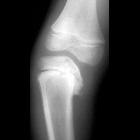Morbus Blount








Blount disease refers to a local disturbance of growth of the medial aspect of the proximal tibial metaphysis and/or epiphysis that results in tibia vara. The condition is commonly bilateral.
Epidemiology
There is no recognized inheritance pattern.
Clinical presentation
Clinically, the child often presents with leg bowing (tibia vara) with little or no associated pain.
Pathology
A relative lack of growth of the medial proximal tibial physis occurs, likely secondary to an increase in compressive forces on the proximal tibial physis.
Subtypes
There are infantile, juvenile and adolescent forms. The infantile type is 5x more frequent than the others and is seen particularly in early walkers. It appears to be the result of abnormal compressive forces inhibiting growth at the medial growth plate and not from avascular necrosis.
The adolescent type occurs in older overweight children and is a milder disease. It is often unilateral and post-traumatic.
Classification
The condition can be classified into six stages according to the system proposed by Langenskiold et al. . See: Langenskiold classification of Blount disease.
Associations
Childhood obesity, in particular for the adolescent type .
Radiographic features
The tibial shaft is in the varus position, and the epiphysis is wedge-shaped, fragmented or can appear absent. The adjacent metaphysis is also depressed and has a beak-like protuberance of rarified bone oriented medially. This causes the metaphyseal-diaphyseal angle of Drennan to increase (typically more than 11º). The lateral cortical wall of the upper tibial metaphysis remains notably straight.
Pre-operative MRI can be used to detect physeal bone bars.
Treatment and prognosis
Treatment depends on the subtype and stage. As a general rule:
- infantile or early stage: often conservatively managed
- adolescent or late stage: a proximal tibial osteotomy is often considered
History and etymology
It was first described by Blount in 1932.
Differential diagnosis
For leg bowing consider: differential for leg bowing in children.
Siehe auch:
- Aseptische Knochennekrose
- Rachitis
- Biegungsbruch
- Tibiaverbiegung bei Kindern
- Tibia vara
- Verbiegung der langen Röhrenknochen
- Langenskiold classification of Blount disease
- fokale fibrokartilaginäre Dysplasie
- Beinverbiegung bei Kindern
- Klassifikation Morbus Blount nach Smith
und weiter:

 Assoziationen und Differentialdiagnosen zu Morbus Blount:
Assoziationen und Differentialdiagnosen zu Morbus Blount:





